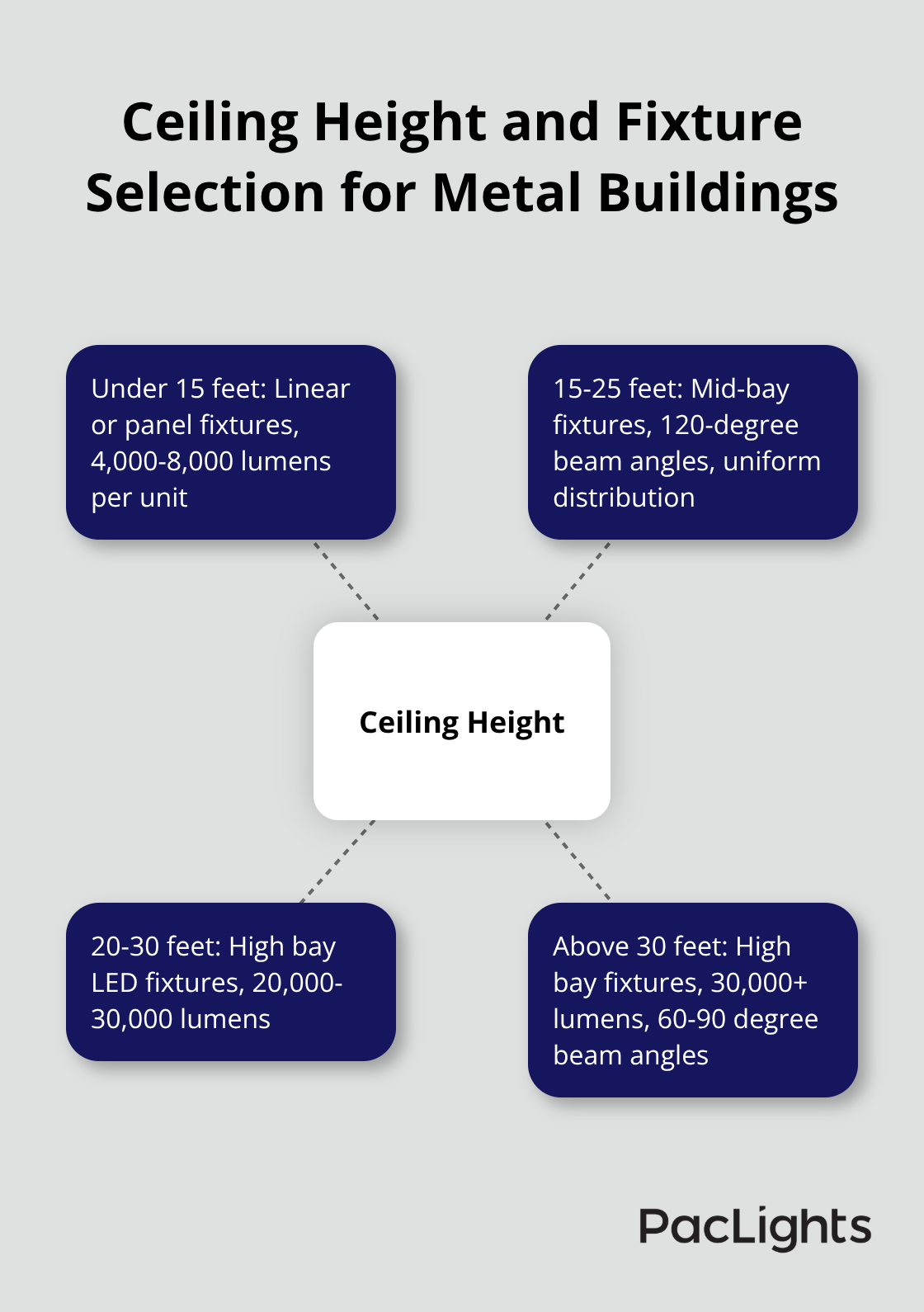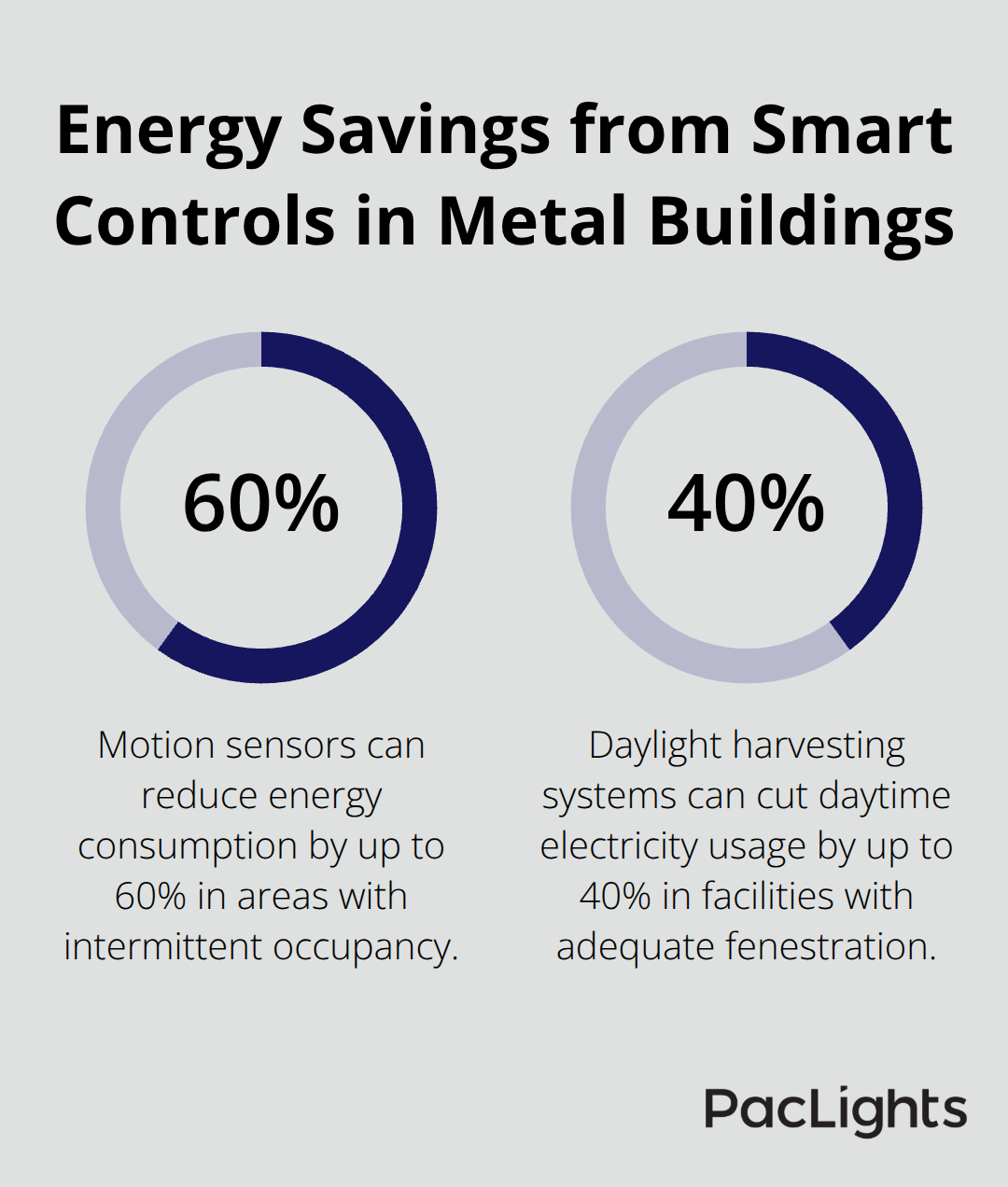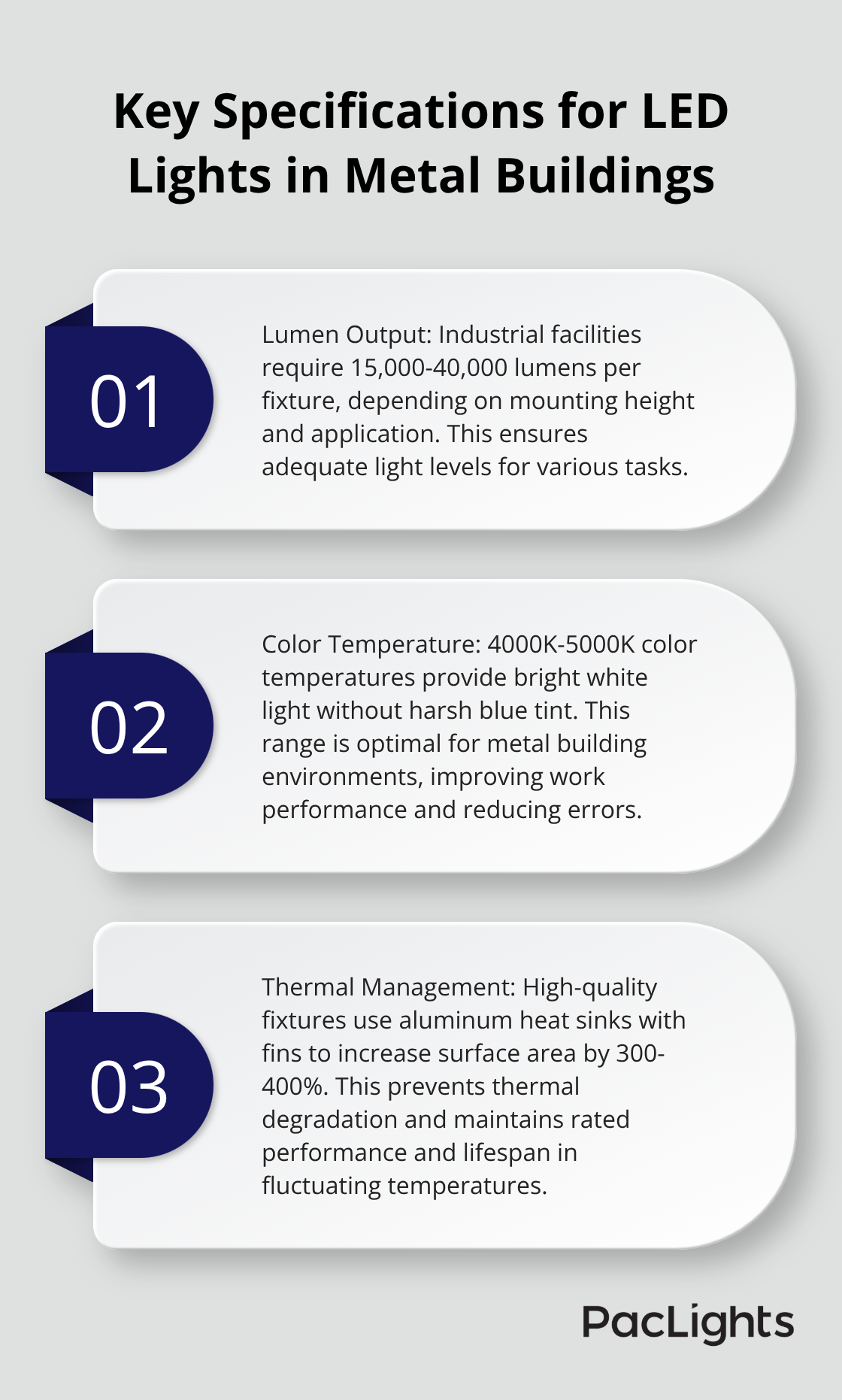Metal buildings present unique lighting challenges that standard fixtures often can’t handle. Poor lighting affects productivity, safety, and energy costs in warehouses, manufacturing facilities, and agricultural structures.
We at PacLights understand that selecting the right LED lights for metal building applications requires careful consideration of factors like ceiling height, environmental conditions, and long-term durability.
What Lighting Requirements Do Metal Buildings Have
Metal buildings demand precise lighting calculations based on measurable factors that directly impact performance and costs. A 40,000 square foot warehouse with 30-foot ceilings requires approximately 50-75 foot-candles for general operations, while precision work areas need 100+ foot-candles according to Illuminating Engineering Society standards. High bay LED fixtures with 20,000-30,000 lumens work best for spaces above 20 feet, while lower ceiling applications under 15 feet perform better with linear or panel fixtures that produce 4,000-8,000 lumens per unit.
Ceiling Height Determines Fixture Selection
Buildings with ceilings between 15-25 feet need mid-bay fixtures with 120-degree beam angles to achieve uniform light distribution without dark spots. Facilities that exceed 30 feet require fixtures outputting 30,000 lumens with narrow beam angles of 60-90 degrees to concentrate light downward effectively. The inverse square law means that doubling mounting height reduces light levels by 75%, which makes proper fixture selection essential for avoiding over-lighting or under-lighting scenarios.

Environmental Conditions Shape Durability Needs
Metal buildings experience temperature swings from -20°F to 120°F, which requires LED drivers rated for extreme conditions and thermal management systems that prevent premature failure. Humidity levels above 60% demand IP65-rated fixtures with sealed housings to prevent moisture infiltration that causes corrosion and electrical failures. Agricultural and manufacturing facilities with airborne particles need fixtures with smooth surfaces and minimal crevices where dust accumulates (this reduces maintenance frequency from monthly to quarterly cleaning cycles).
Light Distribution Patterns Affect Productivity
Wide beam patterns work best for general storage areas where uniform illumination prevents shadows between tall shelving units. Task-oriented spaces like assembly lines require asymmetric distribution patterns that direct light precisely where workers need it most. This approach reduces eye strain and improves accuracy rates by up to 23% based on workplace lighting studies from the American Society of Safety Professionals.
Power Requirements and Load Calculations
Electrical systems in metal buildings must handle the total wattage load of all fixtures plus a 20% safety margin for future expansion. A typical 100,000 square foot facility with 150 high bay LED fixtures (each consuming 200 watts) requires approximately 30kW of electrical capacity. Most metal buildings use 480V three-phase power distribution, which reduces wire gauge requirements and installation costs compared to 120V or 240V systems.
These technical requirements directly influence which LED features matter most for your specific metal building application.
What LED Specifications Matter Most
Metal building LED fixtures must deliver specific performance metrics that directly impact operational costs and worker productivity. Lumen output serves as the primary measurement for light quantity, with industrial facilities that require 15,000-40,000 lumens per fixture depending on mounting height and application. Energy efficiency ratings measured in lumens per watt determine long-term electricity costs, where top-performing LED fixtures achieve 130-150 lumens per watt compared to older metal halide systems that produce only 80-100 lumens per watt. This efficiency difference translates to 40-50% lower energy consumption over the fixture’s 50,000-hour lifespan.
Color Temperature Affects Work Performance
Metal buildings benefit from 4000K-5000K color temperatures that provide bright white light without the harsh blue tint of 6000K+ options. Manufacturing facilities that use 5000K LED fixtures report 15% fewer assembly errors according to National Institute for Occupational Safety and Health studies. Agricultural applications perform better with 4000K temperatures that reduce stress in livestock while they maintain adequate visibility for workers. Color Rendering Index values above 80 CRI allow workers to distinguish colors accurately, which prevents costly mistakes in quality control processes and material handling operations.
Smart Controls Maximize Energy Savings
Motion sensors reduce energy consumption by 30-60% in areas with intermittent occupancy like storage zones and loading docks (particularly effective in facilities with irregular work schedules). Daylight harvesting systems automatically dim fixtures when natural light enters through skylights or translucent panels, which cuts daytime electricity usage by 25-40% in facilities with adequate fenestration. Advanced networked controls allow facility managers to schedule lighting zones independently, monitor energy usage in real-time, and receive maintenance alerts before fixtures fail. These control systems typically pay for themselves within 18-24 months through reduced energy costs and extended fixture life from optimized operation cycles.

Thermal Management Prevents Premature Failure
LED fixtures generate heat that must dissipate properly to maintain rated performance and lifespan. High-quality fixtures use aluminum heat sinks with fins that increase surface area by 300-400% compared to basic designs (this prevents thermal degradation that reduces light output by 30% within two years). Passive cooling systems work best in metal buildings where ambient temperatures fluctuate dramatically, as they contain no moving parts that can fail in dusty or humid conditions.
These specifications directly influence installation requirements and long-term maintenance needs for your metal building project.
How Do You Install LED Lights in Metal Buildings
Metal building installations require specific mounting hardware that withstands thermal expansion and structural movement. Steel purlins and I-beams need aircraft cable suspension systems rated for 50% more than fixture weight to account for vibration from equipment and wind loads. Chain mounting fails within 3-5 years due to metal fatigue, while aircraft cable systems maintain integrity for 15+ years in industrial environments.
Mounting Methods for Different Heights
Pendant mounting works best for fixtures above 25 feet, with 6-12 inch stems that position lights below structural obstructions while maintaining proper light distribution angles. Surface mounting directly to structural members reduces installation time by 40% but limits flexibility for future layout changes. Suspended fixtures allow easier maintenance access and better light distribution control in facilities with irregular ceiling configurations.
Electrical System Retrofits
Most metal buildings use 480V three-phase distribution that reduces wire gauge requirements by 60% compared to 277V systems. Existing metal halide ballasts consume 20-30% more power than rated fixture wattage, so LED retrofits often operate within current electrical capacity without panel upgrades. Older buildings with aluminum wiring require copper pigtails at connection points to prevent galvanic corrosion that causes voltage drops and fire hazards.
Circuit Protection and Power Factor
Circuit breaker sizing needs adjustment because LED fixtures have lower inrush current but different power factor characteristics than discharge systems. Power factor correction capacitors from old ballast systems must be removed to prevent over-correction that damages LED drivers. Most industrial LED fixtures operate at 0.9+ power factor (which eliminates utility penalties for poor power factor that can add 15-20% to monthly electric bills).
Warranty Coverage and Component Quality
Industrial LED fixtures should include 10-year warranties with guaranteed lumen maintenance above 90% throughout the warranty period. Driver failures account for 80% of LED fixture problems, so separate 7-year driver warranties indicate higher quality components. Fixtures with field-replaceable drivers cost $40-60 more initially but save $200-300 per failure versus complete fixture replacement. Temperature derating specifications matter more than basic IP ratings because metal buildings experience extreme thermal cycling that standard commercial fixtures cannot handle.
Final Thoughts
Metal building facilities need LED lights that deliver 15,000-40,000 lumens per fixture with color temperatures between 4000K-5000K and CRI values above 80. Motion sensors and daylight harvesting controls cut energy consumption by 30-60%, while proper thermal management prevents the 30% light degradation that affects poorly designed fixtures. Quality LED lights for metal building applications provide energy savings of 40-50% with 50,000-hour lifespans that create payback periods of 18-36 months.
Installation success requires aircraft cable mounting systems, proper circuit protection, and correct power factor management. Facilities with existing 480V three-phase systems typically accommodate LED retrofits without electrical panel upgrades. Quality fixtures with 10-year warranties and field-replaceable drivers minimize maintenance disruptions and reduce long-term replacement costs.

We at PacLights specialize in metal building LED solutions that meet the demanding requirements of industrial environments. Our team provides lighting layout designs and ROI assessments that help facility managers evaluate their LED conversion projects. These services support informed decision-making for metal building lighting investments (particularly for facilities with complex operational requirements).


Disclaimer: PacLights is not responsible for any actions taken based on the suggestions and information provided in this article, and readers should consult local building and electrical codes for proper guidance.